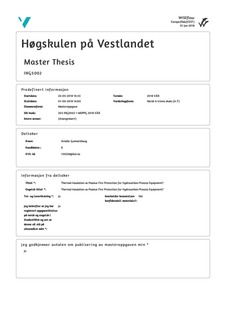| dc.description.abstract | The use of thermal insulation and passive fire protection (PFP) raises concerns in the process industry due to potential corrosion under insulation (CUI). Corrosion related incidents is one of the costliest problems facing the oil and gas industry today, especially in aging facilities. To limit corrosion related to CUI, an improved insulation methodology has been developed. An air gap of 25 mm is introduced to prevent direct contact with potentially soaked insulation. This improved method requires more space and may therefore not allow for the previously added 50 mm layer of PFP. To make space for the PFP extensive construction work is needed. To demonstrate that thermal insulation may provide sufficient fire protection without PFP would therefore be beneficial. This has recently been done for 16 mm thick steel column walls, representing a significant heat sink. The objective of the present work was to demonstrate the PFP performance of regular thermal insulation for thinner steel thicknesses and investigate the thermal insulation “breakdown” temperatures.
A small-scale mock-up simulating a part of a typical distillation column, with the recommended 25 mm air gap, was exposed to small-scale jet fires. The steel disks of diameter 320 mm were insulated radially and on the top surface to minimize external heat losses. The testing was done in a horizontal orientation to minimize internal convective heat losses, i.e. a conservative approach. A 28 kW cylindrical propane burner aligned vertically, exposed the downward facing mock-up cladding. Thermocouples were used to record the temperature development in the cladding, insulation and the internal steel plates. The test set-up was modified to give stable heat flux exposure levels. Results are presented for four different steel wall thicknesses; 3 mm, 6 mm, 12 mm and 16 mm, exposed to heat fluxes in the range 250 – 350 kW/m2.
Requiring the highest recorded temperature in the steel plate not to exceed 400 °C during the first 30 minutes was used as the performance criterion in the present work. There was a clear relation between the steel plate thickness and the recorded temperature increase in the steel with exposure time. The thinner the steel plate was, the faster it reached temperatures above the set performance criterion. The temperature recordings during the tests with 16 mm steel plates did not reach temperatures exceeding 400 °C within the 40 minutes test period, while the 3 mm steel plate reached temperatures exceeding 400 °C within 25 minutes. This can be explained by more heat being required to heat thicker steel plates representing a larger heat sink.
To investigate how the thermal insulation behaves when heated, test samples of the insulation (5 cm · 5 cm · 5 cm) were treated in a muffle oven to 700 °C, 750 °C, 800 °C, 900 °C, 1000 °C and 1100 °C. The holding time at the referred maximum temperatures was 30 minutes. Thermocouples were placed in the insulation and in the upper part of the oven (to measure the oven temperature). After testing, the insulation had shrunk i.e. lost height, the colour had changed, and the material had become firmer with a crumbly consistency. The temperature recordings inside the thermal insulation showed internal heat release at about 300 °C and 900 °C. The heat release at 300 °C may be explained by the combustion of anti-dusting materials (oil products). The heat release at about 900 °C was likely due to combustion of the binder material (Bakelite).
The thermal insulation showed surprisingly good fire resistance, even with a 3 mm steel plate thickness. The stainless-steel cladding protected the thermal insulation from direct fire exposure, hence preserved the thermal insulation for a longer period of time. The tests indicated that the thermal insulation collapsed when exposed to temperatures above 1200 °C. There were some variations between the different tests conducted with the same steel plate thickness. The tests did, however, show a clear connection between the steel plate thickness and the temperature development in the steel. The test set-up itself seemed to work well and gave a good indication of the temperature development in the steel. More tests should be performed to determine the variability in the small-scale jet fire tests. It is also recommended to perform repeated oven testing at higher temperatures, as the insulation still was in good shape after heating up to 1100 °C. It may also be interesting to see how an additional layer of PFP, e.g. 10 mm, will prolong the time to collapse for the thermal insulation during fire testing. | nb_NO |

